Introduction
The eggs of the original silky fowl are well known in the Orient and for thousands of years have been credited with famous medicinal and health-promoting values. However, a modern scientificapproachhas only recently been applied to determine its medicinal, chemical and biochemical components (Sakakibaraet al., 2000; Ferrand and L’ Hermite, 1985). Recently, silky fowls eggs are considered to be a chemical storehouse and an excellent source of sialic acid (Koketsuet al., 2003), which is an important biological properties (Koketsuet al., 1995; Koketsuet al., 1997) and that silky fowl eggs are considered to be an excellent food material (Koketsu and Toyosaki, 2004; Toyosaki and Koketsu, 2004, 2008; Toyosaki, 2012).
In this review, it is a status report regarding silky fowl egg is not found almost. Since the author has been tracking for silky fowl egg, I will discuss those results.
Study on nutritive constituents of silky fowl egg
In the present study, proportional parts, amounts of major constituents, vitamins, minerals and fatty acids composition of silky fowl eggs were examined compared with those of hen’s eggs. The ratio of egg yolk weight to whole egg weight of silky fowl egg was significantly larger than that of egg yolk of hen’s egg (Table 1). The amounts of cholesterol of silky fowl egg were significantly (p<0.01) lesser than those of hen’s egg (Table 2). The amounts of vitamins (B2, B6, D andE) and calcium and potassium of silky fowl egg were significantly larger than those of hen’s egg (Table 3). Unsaturated fatty acids in silky fowl eggs were 62.5% among total fatty acids, the unsaturated fatty acids of hen’s eggs were 53.9% (Table 4). Especially, the contents of arachidonic acid, docosapentaenoic acid and docosahexaenoic acid in silky fowl eggs were significantly larger than hen’s eggs.
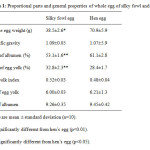 |
Table 1: Proportional parts and general properties of whole egg of silky fowl and hen |
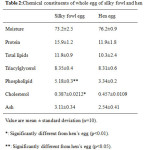 |
Table 2: Chemical constituents of whole egg of silky fowl and hen |
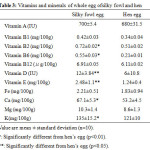 |
Table 3: Vitamins and minerals of whole egg of silky fowl and hen |
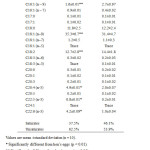 |
Table 4: Fatty acid compositions of whole egg of silky fowl and hen |
Oxidative stability of silky fowl egg
Oxidative stability of original silky fowl’s eggs was investigated. The silky fowl’s whole eggs indicated significantly oxidative stability compared to hen’s eggs in the storage for 14 days. The hen’s eggs increased amount of hydro peroxides from 6 days storage drastically at room temperature, on the other hand, the silky fowl’s eggs restricted generation of hydro peroxides until 8 days and then increased it gradually (Figs. 1, 2). Though pigment extracted with chloroform : methanol (2:1) solvent from hen’s whole egg turned brownish for 14 days, the pigment extracted from silky fowl’s whole egg turned slowly brownish (Fig. 3). Unsaturated fatty acids in silky fowl eggs were 62.5% among total fatty acids, the unsaturated fatty acids of hen’s eggs were 53.9% (Table 4). It was speculated that the oxidative stability of silky fowl’s eggs resulted from higher ratio of unsaturated fatty acids in the eggs.
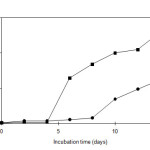 |
Figure 1: Amount of hydroperoxides in whole silky fowl’s eggs (-●-) and hen’s eggs (-■-) |
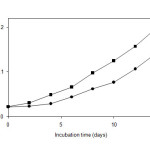 |
Figure 2: Amount of malonaldehyde in whole silky fowl’s eggs (-●-) and hen’s eggs (-■-) |
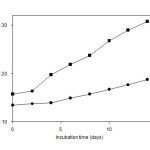 |
Figure 3: Observation of browning of whole silky fowl’s eggs (-●-) and hen’s eggs (-■-) |
Rheologic properties, and oxidative stability of baked sponge cake using silky fowl egg
Baked sponge cakes using silky fowl egg and those using hen egg were prepared, respectively. The rheologic properties, lipid peroxidation and water content of the baked sponge cakes using silky fowl egg compared with those of the cakes using hen egg. The height of the baked sponge cake using silky fowl egg became higher than that of the sponge cake using hen egg (Fig. 4). The baked sponge cake using silky fowl egg showed hardly change in hardness and adhesion of the cake for 10 days at room temperature. In contrast, the cake using hen egg increased drastically a hardness of the cake and decreased an adhesion of the cake (Figs. 5, 6). Though water content of the sponge cake using silky fowl egg showed hardly change on 10 days of storage at room temperature, the cake using hen egg significantly decreased water content of the cake (Fig. 7). The sponge cake using silky fowl egg showed restricted generation of hydro peroxides for 10 days in storage at room temperature. In contrast, the cake using hen egg showed an increased amount of hydro peroxides for 10 days (Fig. 8). The present experiments suggested that the use of silky fowl egg could improve a quality and oxidative stability of baked cakes.
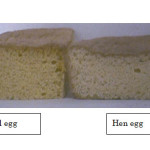 |
Figure 4: Comparison of appearance and height between sponge cake using silky fowl egg and hen egg |
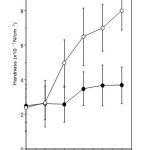 |
Figure 5: Comparison of hardness of the sponge cake using silky fowl egg (●) and hen egg (○) for 10 days. Each value represents the mean ± standard deviation |
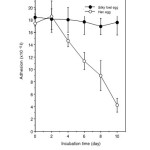 |
Figure 6: Comparison of adhesion of the sponge cake using silky fowl egg (●) and hen egg (○) for 10 days. Each value represents the mean ± standard deviation |
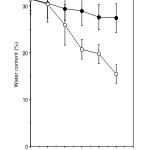 |
Figure 7: The changes of water content of the sponge cake using silky fowl egg (●) and hen egg (○) for 10 days. Each value represents the mean ± standard deviation |
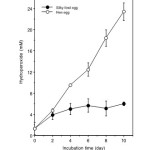 |
Figure 8: Amount of hydroperoxide in sponge cake using silky fowl egg (●) and hen egg (○) for 10 days. Each value represents the mean ± standard deviation |
Conclusion
In this review, for silky fowl egg, it was discussed about the results the authors have been studying. First, were analyzed for the nutritional components as silky fowl egg, was compared with the hen egg. As a result, the silky fowl egg, that it has excellent characteristics nutritionally revealed. Studies regarding food biological functional properties of silky fowl egg, the oxidation stability is better revealed. In order to elucidate the food biological functional properties of silky fowl egg, a result that creates a sponge cake, was tracked from physical standpoint, it is that there are characteristics that food biological function characteristics were better than Hen egg in silky fowl egg. But it has been confirmed. From these results, the silky fowl egg, that it is of excellent properties when viewed in food biological or nutritional has been confirmed.
Refernces
- Ferrand R. and L’Hermite A.: Experimental analysis of the extensive pigmentation in the Silky fowl embryo: evidence for an environmental regulatory process.Experientia,41: 512-514 (1985).
CrossRef - KoketsuM., Sakuragawa E., Linhardt R. J.and Ishihara H.: Distribution of N-acetylneuraminic acid and sialylglycan in eggs of the Silky fowl. British Poultry Science 44: 145-148 (2003).
CrossRef - Koketsu M., T. Nitoda T.,L.R. Juneja L. R.,M. Kim M., Kashimura N.and Yamamoto T.:Sialyloligosaccharides from egg yolk as an inhibitor of rotaviral infection.Journal of Agricultural and Food Chemistry 43: 858-861(1995).
CrossRef - Koketsu M., Nitoda T.,Sugino H.,Juneja L. R., Kim M., Yamamoto., T., Abe N.,Kajimoto T.and Wong C. H.: Synthesis of a novel sialic acid derivative (sialylphospholipid) as an antirotaviral agent. Journal of Medicinal Chemistry 40: 3332-3335 (1997).
CrossRef - Koketsu M. and Toyosaki T.: Nutritive constituents of silky fowleggs: comparison with hen eggs of White Leghorn origin.Animal Science Journal75:67-69 (2004).
CrossRef - Sakakibara K., Tabata S., Shiba N.,T. Gotoh T., Nishimura S.and H. Iwamoto H.: Myofibre composition and total collagen content in Miliotibialislateralis and M. pectoralis of Silky and White Leghorn chickens. British Poultry Science 41: 570-574(2000).
CrossRef - Toyosaki T. and M. Koketsu K.: Oxidative stability of silky fowl eggs. Comparison with hen eggs.Journal of Agricultural and Food Chemistry52:1328-1330 (2004).
CrossRef - Toyosaki T. and M. Koketsu M.: Antioxidant effects of the water-soluble fraction of baked sponge cake made with silky fowl egg: comparison with White Leghorn egg. British Poultry Science 48: 449-453 (2008).
CrossRef - Toyosaki T.: Partial purification of an antioxidizing component in Silky fowl egg. Advance of Food Sciences and Technology4: 34-38 (2012).

This work is licensed under a Creative Commons Attribution 4.0 International License.





